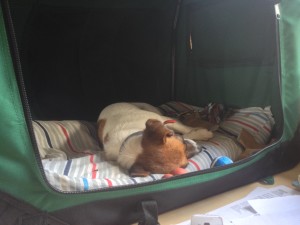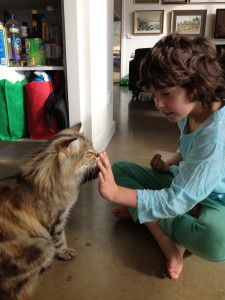Pets and infants
Many have heard the horrific news a few days ago about a baby being attacked in the face by the family dog: A usually placid dog, it came as a shock to the parents of the child. They love their dog and now face a difficult road, not only with the worry for their baby, but also what choices they will make for the fate of their dog.
For the report you can follow the link:
http://www.abc.net.au/news/
ABOVE: Izzy’s first introduction to her crate. We made it comfortable and snuggly in the crate and threw into it her favourite chew toy filled with a yummy treat. Initially she cannot get in to her toy and so the crate becomes a place where she really wants to be.
It is a keen reminder of how quickly such things can happen. Such a situation is devastating for the child, the dog and the family at a time that is meant to be particularly joyful.
Nobody expects their beloved and placid family dog to attack a defenceless baby who is not physically approaching or cornering their pet. Parents can be more wary with toddlers that can pull on fur and interact with their pet but they may be unaware that their new baby is also at risk.
Usually, this sort of tragedy can come about due to a dog’s anxiety about this new thing in the dog’s usually safe and routine environment. A baby may not seem like a human to a dog. People often think a dog is jealous. New parents may try to spend more time with their dog but cannot conceivably stick to the old routines that they once had. If their dog performs a behaviour they do not like, an owner may use punishment, which can increase the rate of aggression in any dog and can certainly cause further problems if the dog is associating punishment with the arrival of this new thing in the dog’s previously safe home.
There is no evidence that dogs are ever jealous of a new baby in their home, but the baby is something new and slightly mobile, it has a strange smell, and it makes lots of new and disruptive sounds. It also may seem to the family pet to be the root of all the reasons that there is a huge disruption in routine. All these factors and the many other new things that come about at that time, can increase uncertainty for a dog and anxiety can be a result.

Cases like the one in Campbelltown can lead to a family unwillingly deciding to euthanase their pet, or the pet being labelled as a dangerous animal with the council, which can be very restrictive on lifestyle. For a family with a newborn, this could make time with the beloved family dog even more difficult to gain.
Prevention of this sort of tragedy can be made possible. It is vital that pet owners are educated in how to reduce risks. Education should start early for any pet owner who is thinking or planning to have a baby, or who is already pregnant.
Tell Your Dog You’re Pregnant is a useful resource written by Dr Lewis Kirkham BVSc MACVSc (veterinary behaviour) and includes advice for preparation of the dog as well as a CD of baby sounds and recommendations on how to introduce them to the dog. He has also brought out a second book Tell Your Cat You’re Pregnant which is tailored to cat owners.
I strongly recommend any parents become informed and not assume that their child is safe with their pet.
Even supervised interactions can sometimes go wrong because the parents do not understand what the dog is trying to say with its body language. The Family Dog website has some good YouTube video footage to help dog owners understand when their dog is worried. A good and easy to watch video is this one: https://www.youtube.com/

Many pet owners think that their dog understands what they say and understands what is going on in its environment. Dogs can read some human body language, but they cannot listen in to our conversations and understand what is going on.
Contrary to popular belief, dogs do not have the cognitive capacity of an adult human, they do not understand English, and we cannot expect them to be able to adapt and understand without helping them in some way through our own behaviour as owners.
As a veterinarian, I want to promote a happy and healthy pet relationship with a new family member. Dogs can provide a wonderful opportunity for children to learn compassion, empathy and care for others. They are great for human health and improve our lifestyle.
I’m now 32 weeks pregnant so I am feeling a bit passionate about this! 🙂

